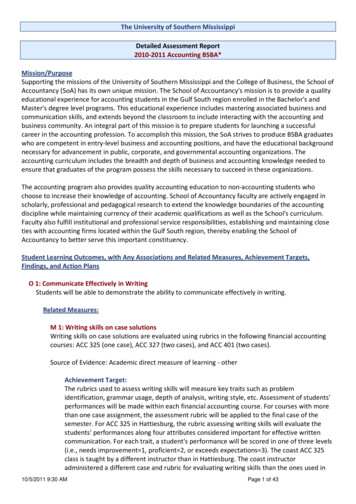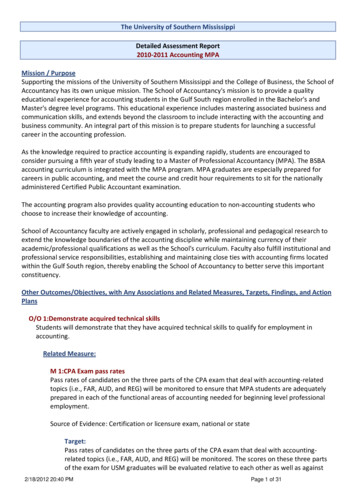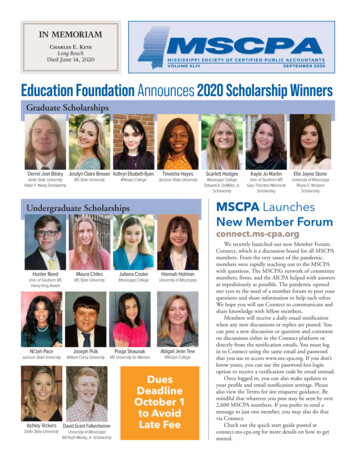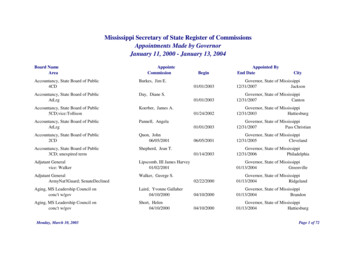
Transcription
The University of Southern MississippiDetailed Assessment Report2010-2011 Accounting BSBA*Mission/PurposeSupporting the missions of the University of Southern Mississippi and the College of Business, the School ofAccountancy (SoA) has its own unique mission. The School of Accountancy's mission is to provide a qualityeducational experience for accounting students in the Gulf South region enrolled in the Bachelor's andMaster's degree level programs. This educational experience includes mastering associated business andcommunication skills, and extends beyond the classroom to include interacting with the accounting andbusiness community. An integral part of this mission is to prepare students for launching a successfulcareer in the accounting profession. To accomplish this mission, the SoA strives to produce BSBA graduateswho are competent in entry-level business and accounting positions, and have the educational backgroundnecessary for advancement in public, corporate, and governmental accounting organizations. Theaccounting curriculum includes the breadth and depth of business and accounting knowledge needed toensure that graduates of the program possess the skills necessary to succeed in these organizations.The accounting program also provides quality accounting education to non-accounting students whochoose to increase their knowledge of accounting. School of Accountancy faculty are actively engaged inscholarly, professional and pedagogical research to extend the knowledge boundaries of the accountingdiscipline while maintaining currency of their academic qualifications as well as the School's curriculum.Faculty also fulfill institutional and professional service responsibilities, establishing and maintaining closeties with accounting firms located within the Gulf South region, thereby enabling the School ofAccountancy to better serve this important constituency.Student Learning Outcomes, with Any Associations and Related Measures, Achievement Targets,Findings, and Action PlansO 1: Communicate Effectively in WritingStudents will be able to demonstrate the ability to communicate effectively in writing.Related Measures:M 1: Writing skills on case solutionsWriting skills on case solutions are evaluated using rubrics in the following financial accountingcourses: ACC 325 (one case), ACC 327 (two cases), and ACC 401 (two cases).Source of Evidence: Academic direct measure of learning - otherAchievement Target:The rubrics used to assess writing skills will measure key traits such as problemidentification, grammar usage, depth of analysis, writing style, etc. Assessment of students'performances will be made within each financial accounting course. For courses with morethan one case assignment, the assessment rubric will be applied to the final case of thesemester. For ACC 325 in Hattiesburg, the rubric assessing writing skills will evaluate thestudents' performances along four attributes considered important for effective writtencommunication. For each trait, a student's performance will be scored in one of three levels(i.e., needs improvement 1, proficient 2, or exceeds expectations 3). The coast ACC 325class is taught by a different instructor than in Hattiesburg. The coast instructoradministered a different case and rubric for evaluating writing skills than the ones used in10/5/2011 9:30 AMPage 1 of 43
Hattiesburg. The coast rubric will measure a single trait reflecting writing skills. This trait willcapture a student's "ability to communicate the response succinctly and effectively inwritten form." Individual students will be assessed on this trait as follows: did not meetexpectations 1 met expectations 2 exceeded expectations 3. Because writing skillsprogress across the accounting curriculum and because it is anticipated that studentsentering the accounting major (i.e., ACC 325) will not demonstrate proficient writing skills,the assessment of writing skills in ACC 325 is used as a baseline for measuring subsequentimprovement. Therefore, no achievement target is assigned to ACC 325. ACC 327 is taughtby the same instructor on both campuses, and he uses the same cases and rubrics toevaluate writing skills at both locations. ACC 327 follows ACC 325 in the sequence ofaccounting courses. In ACC 327 the instructor will provide students with a summary of basicgrammar rules and will instruct them on how to prepare appropriate written solutions toaccounting cases. On the second and final case in ACC 327, students will be evaluated alongfour traits (i.e., problem identification, grammar, professional presentation, and writingstyle). Each trait will be assessed as follows: needs improvement 1 proficient 2 exceedsexpectations 3. The achievement target will have been met if the mean score for all traitsassessed equals or exceeds 2.0 (proficient). ACC 401 (which follows ACC 327 in the financialaccounting sequence) is taught by the same instructor on both campuses, and he will use arubric for evaluating writing skills similar to the one used by the ACC 327 instructor andHattiesburg ACC 325 instructor. The achievement target will have been met if the meanscore for all traits assessed equals or exceeds 2.0 (proficient)Findings (2010-2011) - Achievement Target: MetACC 325 (Assessment Baseline)In Hattiesburg ACC 325, students were assessed on writing skills as follows:did not meet expectations 1met expectations 2exceeded expectations 3Mean scores for the rubric follow:AttributeMean ScoreProblem identificationGrammarProfessional presentationWriting style1.241.881.381.47The mean score for the written communication trait in ACC 325 on the coast was1.81. ACC 325 is taken by accounting students in the first semester of their junioryear, and they are not necessarily expected to have good writing skills at this point.Indeed, on both campuses, the students in ACC 325 demonstrated relatively weakwriting skills with mean scores in this area below a 2.00 (i.e., the “proficient” or “metexpectations” level).ACC 327 (which follows ACC 325 in the sequence of financial accounting courses)was taught by the same instructor on both campuses, and he used the same casesand rubrics to evaluate writing skills at both locations. In ACC 327 the instructorprovides students with a summary of basic grammar rules and instructs them onhow to prepare appropriate written solutions to accounting cases. On the second10/5/2011 9:30 AMPage 2 of 43
and final case in ACC 327, students are evaluated along four traits (i.e., problemidentification, grammar, professional presentation, and writing style). Each trait isevaluated as follows:needs improvement 1proficient 2exceeds expectations 3The mean scores for these traits on the two campuses are as follows:AttributeMean ScoreProblem identificationGrammarProfessional presentationWriting .93Thus, by the second case in ACC 327 students had made significant improvement intheir writing skills compared to the skills demonstrated in the prior course (i.e., ACC325). For example, on each of the four writing traits on both campuses, the meanscores in ACC 327 fell around 2.00 (i.e., the “proficient” level). On all four traitscombined, 87.5% and 95% of the Hattiesburg and coast students, respectively,scored at the “proficient” level or above.Not surprisingly, since the students had already performed writing assignments inACC 325 and ACC 327, they demonstrated good writing skills in ACC 401 on bothcampuses. The students are assessed in ACC 401 along the same four traitsevaluated in ACC 327 (i.e., problem identification, grammar, professionalpresentation, and writing style) and are assessed on each trait as follows:needs improvement 1proficient 2exceeds expectations 3The mean scores in ACC 401 for the four writing traits on the two campuses are asfollows:AttributeMean ScoreProblem identificationGrammarProfessional presentationWriting .20Notice that, except for professional presentation in Hattiesburg, the mean scores onall traits on both campuses were at or above 2.00 (i.e., the “proficient” level). Eventhe mean score for professional presentation in Hattiesburg was virtually at thispoint (i.e., 1.95), and for this trait in Hattiesburg 14 of the 19 students (i.e., 73.7%)performed at the “proficient” level or above. For the four traits combined, 80.3%and 84.3% of the Hattiesburg and coast students, respectively, scored at the“proficient” level or above.10/5/2011 9:30 AMPage 3 of 43
In summary, based on the assessment of writing skills longitudinally across thecurriculum, the achievement target was met.Further discussion:The assessment results for 2010-2011 indicate that the learning objective for writtencommunication skills is being met. Students display difficulty with their writing skillswhen they enter the upper division accounting classes (i.e., in ACC 325) but by thetime they graduate the students have developed adequate writing skills. During thecourse of their junior and senior years, students are given numerous writingassignments in their sequenced accounting courses (i.e., ACC 325, 327, and 401).These writing assignments are formally evaluated for assessment purposes so thatchanges in writing skills occurring during the program can be determined. In additionto these writing assignments evaluated for assessment purposes, students are alsorequired to prepare several writing assignments in other accounting courses as well(e.g., in ACC 320, 402, 407, and 409). The point here is that the assessment teambelieves the road to effective writing skills involves practice. On each caseassignment, students are given feedback on what could be improved in their writingskills. Just like any other talent, writing skills improve with practice and constructivefeedback. The assessment team feels that the current system is working andrecommends no changes to the curriculum. The present structure of caseassignments should be maintained in the future with appropriate assessmentmeasures used to ascertain if this learning objective continues to be met.M 2: ACC 407 Writing AssessmentWriting skills are evaluated using rubrics for required case studies in ACC 407 (GovernmentalAccounting).Source of Evidence: Project, either individual or groupAchievement Target:Although two assignments will be made, only the last assignment will be evaluated in ACC407. This course (Governmental Accounting) is taught by different faculty between the twocampuses who used different cases and evaluation rubrics. For the coast ACC 407 class, theevaluation rubric for the case assignment will contain multiple questions dealing withvarious issues in the case. One particular trait evaluated by the rubric pertained to writing(i.e., "the student demonstrates the ability to communicate the response succinctly andeffectively in written form"). A student's performance will be evaluated as follows: did notmeet expectations 1 met expectations 2 exceeded expectations 3. The coast ACC 407achievement target will have been met if the mean score for the single trait assessed equalsor exceeds 2.0 (met expectations) For ACC 407 in Hattiesburg, the rubric assessing writingskills will assess students' performances along multiple attributes that will then betranslated into scores of one (lowest) to four (highest). The achievement target will havebeen met if 80 percent or greater receive a score of 3 (out of 4) or greater.Findings (2010-2011) - Achievement Target: MetLate in the accounting curriculum, an assessment of writing skills was made in ACC 407,which is governmental accounting. All other classes involving the assessment of writtencommunication were in sequenced financial accounting courses (i.e., ACC 325, 327, and401). The AOL team wanted at least one writing assessment performed outside offinancial accounting; hence the evaluation in ACC 407. During the 2010-2011 academicyear, the only accounting prerequisite for ACC 407 was ACC 325. So, ACC 407 contained a10/5/2011 9:30 AMPage 4 of 43
mixture of students with some who had already completed ACC 401 and thus had beenthrough all the formal writing assignments in the financial sequence and a few otherswho were taking ACC 407 concurrently with ACC 327. Two writing assignments weremade and graded in ACC 407, with the final assignment evaluated for assessmentpurposes. The course was taught by different faculty between the two campuses whoused different cases and evaluation rubrics.For the Coast ACC 407 class, the evaluation rubric for the case assignment containedmultiple questions dealing with various issues in the case. One particular trait evaluatedon the rubric pertained to writing (i.e., "the student demonstrates the ability tocommunicate the response succinctly and effectively in written form").A student's performance was evaluated as follows: did not meet expectations 1, metexpectations 2, exceeded expectations 3The students' mean score for this trait in the coast ACC 407 class was 2.23, which is wellabove the "met expectations" level and suggests that overall the coast studentsdemonstrate "proficient" writing skills.On the final writing assignment in the Hattiesburg ACC 407 class, 28 of the 30 studentscompleting the assignment received four out of four points available on the assessmentrubric related to writing skills. The instructor, accordingly, concluded that the students'writing skills by the end of this course clearly met his expectations.O 2: Demonstrate competency in current technology.Students will be able to demonstrate competency in current technology.Related Measures:M 3: Information Systems CaseA primary venue for assessing technology competence is a rubric applied to a comprehensivecase assigned in ACC 309, which is an accounting systems course.Source of Evidence: Academic direct measure of learning - otherAchievement Target:The rubric will measure primary spreadsheet (i.e., Excel) skills, including formula auditing,complex IF statements, and complex calculations using VLOOKUP and range means. Thesame instructor teaches ACC 309 on both campuses and will use a similar assignment forassessing spreadsheet skills at both locations. The assessment rubric evaluated the followingfour traits related to spreadsheet skills: Trait 1 - Format spreadsheet to facilitateunderstanding of the content, including grouping and filtering. Trait 2 - Accurately auditformulas. Trait 3 - Use of complex IF statements. Trait 4 - Accurately perform complexcalculations, using VLOOKUP and range names. For each of these four traits, a student'sperformance was rated as either "unacceptable," "acceptable," or "proficient" (i.e., highperforming). The achievement target will have been met if 70 percent of students assesseddemonstrate "acceptable" or greater spreadsheet skills for all four traits assessed. Inaddition to assessing spreadsheet skills, the ACC 309 instructor for the first time will assess astudent's basic understanding of XBRL and its capabilities, which will be the sole traitmeasured in an XBRL project. A student's performance on this trait will be evaluated as"unacceptable," "acceptable," or "proficient" (i.e., high performing). The achievement targetwill have been met if 70 percent of students assessed demonstrate "acceptable" or greaterunderstanding of XBRL.10/5/2011 9:30 AMPage 5 of 43
Findings (2010-2011) - Achievement Target: MetThe results for the four traits on the assessment rubric applied to the ACC 309spreadsheet project on the two campuses are as follows:Hattiesburg campus:Trait 1% of studentsUnacceptable Acceptable Proficient5%86%9%Trait 20%45%55%Trait 314%77%9%Trait 414%68%18%Coast campus:Trait 1% of studentsUnacceptable Acceptable Proficient0%67%33%Trait 24%81%15%Trait 315%52%33%Trait 426%56%18%As shown above, students on both campuses performed reasonably well on the fourspreadsheet traits with, generally, only a small percentage performing at the“unacceptable” level. The primary exception, however, is the performance of the coaststudents on Trait 4 (i.e., accurately performing complex calculations using VLOOKUP andrange names), where 26% of the students scored at an “unacceptable” level. The ACC 309instructor notes that a mitigating circumstance that could explain this less than stellarperformance on the coast for this trait is that the coast class was taught in one-half asemester and met only once a week for eight weeks. The Hattiesburg class met allsemester with two class periods each week. With only eight class periods, the coaststudents did not have time to try a task and come back the next week for furtherinstruction. Plus, there was a widely varying level of technology skills in the coast class,which combined with a relatively large class size, made it difficult for many of the coaststudents to understand the examples in class.The results for the XBRL project for the Hattiesburg and coast campuses are as follows:Understanding XBRL capabilities:% of studentsHattiesburgCoast10/5/2011 9:30 AMUnacceptable Acceptable Proficient0%45%55%0%37%63%Page 6 of 43
Thus, all students on both campuses performed at an “acceptable” level or above on theXBRL assignment.Further discussion:ACC 309 focuses heavily on technology skills, with an emphasis on spreadsheets.Assessment results show that on both campuses, the overwhelming majority of studentsin this course performed at the “acceptable” level or above on all four spreadsheet traitsevaluated in their comprehensive project. Thus, even though the students had trouble indemonstrating effective spreadsheet skills as beginning juniors (i.e., in ACC 320), theyseem to have developed adequate skills by the time they complete ACC 309, which istypically taken by students after the first semester of their junior year (i.e., after they’vetaken ACC 320). Still, though, almost 26% of the coast ACC 309 students performed at an“unacceptable” level on the trait evaluating their ability to accurately perform complexcalculations using VLOOKUP and range names. It appears this difficulty stems from thefact that these students took the course in a short (i.e., 8w2) semester that did not allowthem adequate time to learn and place into practice these more difficult functions withinExcel. To prevent this from recurring in the future, the assessment team recommendsthat ACC 309 not be taught in half semester sessions on either campus but instead betaught in full semester terms only. ACC 309 was taught in a shortened semester on thecoast in the fall 2010 to accommodate the instructor who was unable to teach a fullsemester that term. This restriction no longer exists, and so there should be no reason forteaching ACC 309 in a shortened semester in the future. It should also be noted thatoccasionally some upper-level accounting courses are offered in a shortened (i.e., eightweek) semester to facilitate spring internships. However, based on the assessmentfindings this year for ACC 309, the AOL team recommends this course not be considered aviable candidate for a spring mini-term session.Even though noticeable improvements in spreadsheet skills occurred between ACC 320and ACC 309, the ACC 309 instructor noted that there is still room for improvement as alarge portion of the students on both campuses to perform at a “proficient” (i.e., highperforming) level on the traits evaluating the use of complex IF statements and VLOOKUPto select the data required. She feels that students need more courses requiringspreadsheet assignments (i.e., in essence, spreadsheets across the curriculum) in orderfor them to develop the comfort level needed to perform as accountants. The AOL teamconcurs with the ACC 309 instructor on this point and recommends that at least oneassignment using spreadsheets be incorporated into every upper-level accounting course,with the exception of ACC 480 (advanced business law) and ACC 409 (auditing). Inaddition, the team recommends that a significant spreadsheet assignment be used in ACC401 (advanced accounting) for assessment purposes. This senior level course provides anatural place to evaluate the spreadsheet skills of students nearing completion of theprogram and covers a topic (i.e., consolidations) that is well suited for a majorspreadsheet assignment. Thus, in addition to requiring spreadsheet assignments acrossthe curriculum, three key courses, (i.e., ACC 320, 309, and 401) will be designated ashaving assessment responsibility for spreadsheet skills. With these three classes taken atvarious stages of the program, the assessment results would allow the AOL team to moreclearly gauge the improvements occurring in the students’ spreadsheet skills over thecourse of the program than is possible at the present time. The addition of a majorspreadsheet project in ACC 401 for assessment purposes, however, creates a significantassessment burden on this class as it is already scheduled for assessment in relation toresearch and writing skills (i.e., two assignments) as well assessment of research skillsassociated with online databases such as WRDS (i.e., one assignment). In the past, the10/5/2011 9:30 AMPage 7 of 43
assessment of research skills associated with WRDS occurred in ACC 402. However,beginning in the fall 2011, ACC 402 along with its assessment responsibilities will becollapsed into ACC 401. Thus, to lessen the assessment load in ACC 401 and make theaddition of spreadsheet assessment feasible in this course, the assessment teamrecommends eliminating the requirement for assessing research of online databases (i.e.,WRDS) in this course. The team recommends that for assessment purposes this skill beevaluated in ACC 327 in the future.Spreadsheet skills represent an important component of a student’s ability in the area oftechnology but not the only one. In last year’s assessment report, the team recognizedthe importance of students understanding the need for and capabilities of XBRL as areporting format. The team recommended last year that ACC 309 include coverage ofXBRL both for testing and assessment purposes. This change was recommended notbecause of previous assessment findings, but because the team realized that changeswere needed in the curriculum to stay abreast of current practice (i.e., financialstatements submitted to the SEC must now be provided in XBRL format). In the currentyear (i.e., 2010-2011), the ACC 309 instructor covered XBRL mainly from an informationalperspective. The students were required to read about XBRL on Web based materials tolearn about its structure and technology as well as the reasons for the accountingprofession’s requirements for its use. The assessment of the students’ understanding ofXBRL and its capabilities suggest that this goal was achieved this year (i.e., all of the coastand Hattiesburg ACC 309 students scored at the “acceptable” level or above on this trait).Thus, this demonstrates a positive “closing of the loop” in our assessment process in thata prior year’s AOL report recommended changes to the curriculum to keep it current withpractice, the recommended changes were made to the curriculum this year, andassessment testing indicates the changes produced the desired results.Even though the ACC 309 instructor covered XBRL this year (i.e., 2010-2011), she wasunable to acquire the software needed for students to complete sample tasks of creatingand retrieving data using XBRL because the software underwent a major overhaul by thedeveloper and was unexpectedly unavailable for installation in our labs. The long-timeACC 309 instructor retired effective June 30, 2011, and has been replaced by a newinstructor. The assessment team recommends that the new instructor continue theinroads into teaching XBRL made by the former instructor but expand them and acquirethe software for our labs needed for students to get hands-on experience using XBRL tocreate and retrieve data. The team further recommends that the SoA Director follow upwith the ACC 309 instructor on this issue and secure the funding needed to acquire thesoftware. Assuming the software is acquired and operational by spring 2011, the teamalso recommends that the ACC 309 instructor assess the students’ hands-on ability tocreate and extract financial information using XBRL via a project and an evaluation rubric.An “Action Plan” that entails the above was initiated in last year’s assessment report; thisplan has been extended through this year's assessment cycle.M 4: ACC 320 Data AnalysisAssessment of technology competence is measured in ACC 320 by rubrics applied to assignedresearch exercises. These exercises demonstrate the ability of students to access onlinedatabases, import data into Excel spreadsheets perform appropriate analyses within Excel, andcommunicate their results and make recommendations based on their analyses.Source of Evidence: Academic direct measure of learning - other10/5/2011 9:30 AMPage 8 of 43
Achievement Target:ACC 320 (Cost Accounting) is taught by different instructors on the coast and Hattiesburgcampuses, and they use different assignments and rubrics for evaluating spreadsheet skills.In the coast ACC 320 class, students were required to use the WRDS database to collect datarelated to revenue and selling, general and administrative expenses and use that data toperform a regression analysis using Excel and make recommendations to management. Thestudents were required to present all results using Excel. The assessment rubric for thisproject evaluated the following three traits: Trait 1 - Understanding of the WRDS databaseand including relevant data into the spreadsheet analysis. Trait 2 - Understanding ofregression analysis in cost accounting using Excel. Trait 3 - Communicating results usingExcel and making recommendations to management based on the analysis. In theHattiesburg ACC 320 class, the spreadsheet assignment required students to take dataprovided by the instructor and produce and link several operating budgets (e.g., salesbudget, cash budget, etc.). Students were told before the assignment was made that theywould be evaluated on the following two traits: Trait 1 - Demonstrating the ability toproduce an acceptable Excel spreadsheet of their own design. Trait 2 - Communicating theinformation in the spreadsheet in an organized and readable manner. On each of the abovetraits, a student's performance was rated as either "exceeds expectations," "meetsexpectations," or "below expectations." The achievement target will have been met if 70percent or greater of the students assessed in every trait "meets" or "exceeds"expectations.Findings (2010-2011) - Achievement Target: Partially MetCoastA student’s performance on each of the above traits was evaluated as either “exceededexpectations,” “met expectations,” or “did not meet expectations.” For the 23 studentscompleting the assignment in the coast ACC 320 class, the results for each of the threetraits in the assessment rubric are as follows:Trait 1:% ofExceeded expectations Students(85-100% correct) 31%Met expectations(70-84% correct) . 52%Did not meet expectations( 70% correct) . 17%Trait 2:% ofExceeded expectations Students(85-100% correct) 22%Met expectations(70-84% correct) . 39%Did not meet expectations( 70% correct) . 39%10/5/2011 9:30 AMPage 9 of 43
Trait 3:% ofExceeded expectations Students(85-100% correct) 30%Met expectations(70-84% correct) . 57%Did not meet expectations( 70% correct) . 13%The above results indicate the primary area where students had difficulty was the secondtrait (i.e., understanding regression analysis using Excel) where 39% of the studentsperformed at the “did not meet expectations” level.HattiesburgThe results for the two traits on the assessment rubric for the Hattiesburg ACC 320 classare as follows:Trait 1Trait 2Exceeds Expectations24.4%51.2%Meets Expectations19.5%19.5%Below expectations56.1%29.3%For trait 1, students were evaluated on their ability to enter data into a spreadsheet,manipulate the data to produce the required budgets through the use of cell formulas ineach budget, and link the budgets through the use of cell formulas. As indicated above, alarge portion of the students struggled with this trait, as 56.1% of them performed at the“below expectations” level. For trait 2, students were evaluated on the organization ofthe worksheet through the use of appropriate descriptions of all parts of the budgetcalculations as well as the readability of their work (i.e., a reader could follow all the stepstaken to produce the budgets). Overall, the students performed fairly well on this traitwith over 70% of them scoring at the “meets expectations” level or above.Related Action Plans (by Established cycle, then alpha):For full information, see the Action Plan Details section of this report.Increasing ACC 320 Technology-related assignments on the Coast campusEstablished in Cycle: 2009-2010The coast ACC 320 instructor recommends and the assessment team concurs with thefollowing changes to address this outcome. In .ACC 320 Research ExercisesEstablished in Cycle: 2010-2011In the Hattiesburg ACC 320 class, a large portion (i.e., 56.1%) of the students performedat the “below expectations” level on t.10/5/2011 9:30 AMPage 10 of 43
M 5: Internship EvaluationsUpon completion of an internship, the student's supervisor completes a detailed assessment ofthe student's performance. Assessments are made across multiple learning objectives includingcompetency in current technology, ethical decision-making, and basic accounting knowledge andskills.Source of Evidence: Field work, internship, or teaching evaluationAchievement Target:On the intern evaluation rubric, an intern's supervisor will rate the student's competency incurrent technology as follows: below expectations 1 met expectations 2 exceededexpectations 3. The achievement target will have been met if the mean score equals orexceeds 2.0 and no student receives a score of "below expectations.
The University of Southern Mississippi . Detailed Assessment Report 2010-2011 Accounting BSBA* Mission/Purpose. Supporting the missions of the University of Southern Mississippi and the College of Business, the School of Accountancy (SoA) has its own unique mission. The School of Accountancy's mission is to provide a quality










